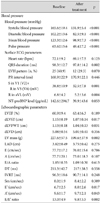1. Zile MR, Brutsaert DL. New concepts in diastolic dysfunction and diastolic heart failure: I. diagnosis, prognosis, measurements of diastolic function. Circulation. 2002. 105:1387–1393.
2. Poulsen SH, Anderson NH, Ivarsen PI, Mogensen CE, Egeblad H. Doppler tissue imaging reveals systolic dysfunction in patients with hypertension and apparent "isolated" diastolic dysfunction. J Am Soc Echocardiogr. 2003. 16:724–731.
3. Aurigemma GP, Silver KH, Priest MA, Gaasch WH. Geometric changes allow normal ejection fraction despite depressed myocardial shortening in hypertensive left ventricular hypertrophy. J Am Coll Cardiol. 1995. 26:195–202.
4. Penicka M, Bartunek J, De Bruyne B, et al. Improvement of left ventricular function after cardiac resynchronization therapy is predicted by tissue Doppler imaging echocardiography. Circulation. 2004. 109:978–983.
5. Leclercq C, Faris O, Tunin R, et al. Systolic improvement and mechanical resynchronization does not require electrical synchrony in the dilated failing heart with left bundle-branch block. Circulation. 2002. 106:1760–1763.
6. Wang J, Kurrelmeyer KM, Torre-Amione G, Nagueh SF. Systolic and diastolic dyssynchrony in patients with diastolic heart failure and the effect of medical therapy. J Am Coll Cardiol. 2007. 49:88–96.
7. Yu CM, Zhang Q, Yip GWD, et al. Diastolic and systolic asynchrony in patients with diastolic heart failure. J Am Coll Cardiol. 2007. 49:97–105.
8. Yang B, Chettiveettil D, Jones F, Aguero M, Lewis JF. Left ventricular dyssynchrony in hypertensive patients without congestive heart failure. Clin Cardiol. 2008. 31:597–601.
9. Chobanian AV, Bakris GL, Black HR, et al. Seventh report of the Joint National Committee on Prevention, Detection, Evaluation, and Treatment of High Blood Pressure. JAMA. 2003. 289:2560–2572.
10. McKee PA, Castelli WP, McNamara PM, Kannel WB. The natural history of congestive heart failure: the Framingham study. N Engl J Med. 1971. 285:1441–1446.
11. Ommen SR, Nishimura RA, Appleton CP, et al. Clinical utility of Doppler echocardiography and tissue Doppler imaging in the estimation of left ventricular filling pressures: a comparative simultaneous Doppler-catheterization study. Circulation. 2000. 102:1788–1794.
12. Suffoletto MS, Dohi K, Cannesson M, Seba S, Gorcsan J 3rd. Novel speckle tracking radial strain from routine black-and-white echocardiographic images to quantify dyssynchrony and predict response to cardiac resynchronization therapy. Circulation. 2006. 113:960–968.
13. Gorcsan J 3rd, Tanabe M, Bleeker GB, et al. Combined longitudinal and radial dyssynchrony predicts ventricular response after resynchronization therapy. J Am Coll Cardiol. 2007. 50:1476–1483.
14. Sokolow M, Lyon TP. The ventricular complex in ventricular hypertrophy as obtained by unipolar precordial and limb leads. Am Heart J. 1949. 37:161–186.
15. Nagueh SF. Mechanical dyssynchrony in congestive heart failure. J Am Coll Cardiol. 2008. 51:18–22.
16. Hawkins NM, Petrie MC, MacDonald MR, Hogg JK, McMurray JJ. Selecting patients for cardiac resynchronization therapy: electrical or mechanical dyssynchrony? Eur Heart J. 2006. 27:1270–1281.
17. Bleeker GB, Holman ER, Steendijk P, et al. Cardiac resynchronization therapy in patients with a narrow QRS complex. J Am Coll Cardiol. 2006. 48:2243–2250.
18. Kass DA. An epidemic of dyssynchrony: but what does it mean? J Am Coll Cardiol. 2008. 51:12–17.
19. Wang J, Kurrelmeyer KM, Torre-Amione G, Nagueh SF. Systolic and diastolic dyssynchrony in patients with diastolic heart failure and the effect of medical therapy. J Am Coll Cardiol. 2007. 49:88–96.
20. Wang YC, Hwang JJ, Lai LP, et al. Coexistence and exercise exacerbation of intraleft ventricular contractile dyssynchrony in hypertensive patients with diastolic heart failure. Am Heart J. 2007. 154:278–284.








 PDF
PDF ePub
ePub Citation
Citation Print
Print



 XML Download
XML Download